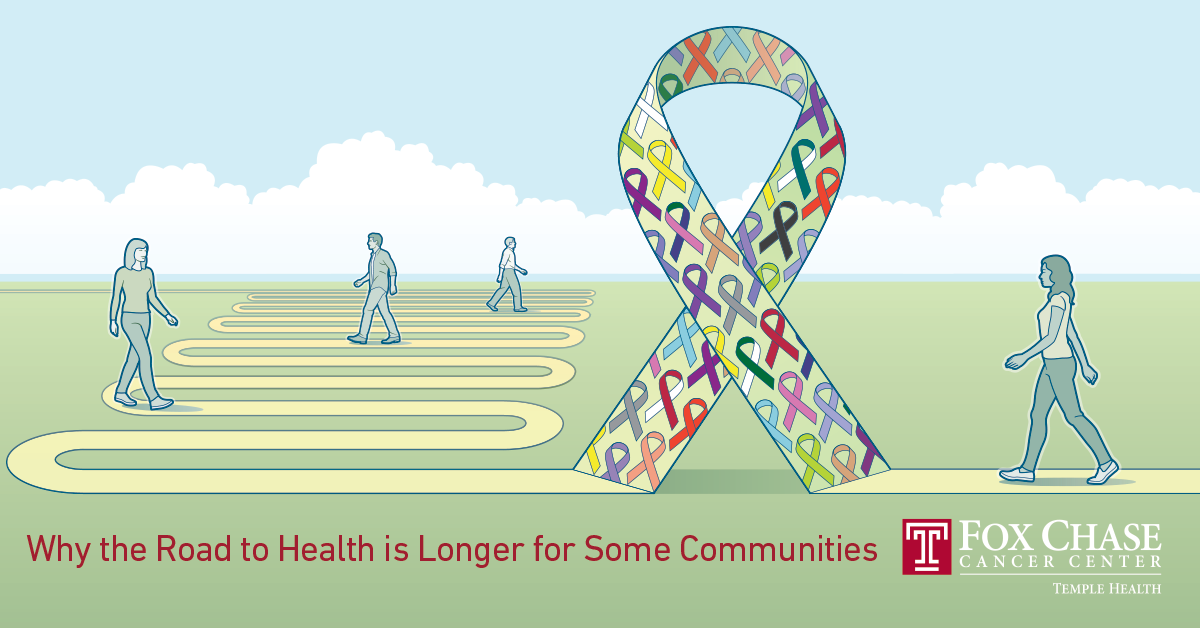
Cancer Disparities: How Cancer Affects Different Populations
-
Updated: February 1, 2021
Anyone can get cancer. However, some populations experience an undue burden of cancer. The adverse impacts cancer has on different populations are known as cancer disparities.
What are cancer disparities?
According to the National Cancer Institute (NCI), cancer disparities are differences in cancer statistics. These include new cases, screening rates, stage at diagnosis, and death. Cancer disparities can also be seen in cancer outcomes—some population groups may be steadily improving, while others are improving at lower rates or falling behind.
What causes these differences?
“Typically, when people think of health disparities, they think of race and ethnicity. But there’s more to health disparities than race,” said Evelyn González, MA, senior director of community outreach at Fox Chase Cancer Center.
“In addition to biological or genetic predispositions, there are other factors that contribute to disparities. These include socioeconomic factors such as income and education. If a person doesn’t have the financial means to afford health insurance or understand the importance of why or when one should screen for cancer you can see how this might contribute to such disparities,” González explained. “Depending on where a person lives or works there may be environmental exposures that can increase a person’s risk for cancer. Couple these issues with lifestyle choices and high-risk behaviors, such as smoking, excessive alcohol use, not being physically active, being obese or having unprotected sex, and you can see the multiple factors that can influence cancer health disparities beyond race and ethnicity.”
What are some common disparities?
According to NCI, these are some common examples of cancer disparities:
- People with lower socioeconomic status are more likely to die of cancer than people with higher status. This is true regardless of race or ethnicity.
- African American women are 40 percent more likely than white women to die of breast cancer.
- Hispanic and American Indian/Alaska Native women have higher rates of cervical cancer than other groups. However, African American women have the highest death rates from the disease.
- American Indians and Alaska Natives have the poorest 5-year survival rates.
- Colorectal cancer screening rates vary widely between ethnic groups. Spanish-speaking Hispanics are less likely to be screened than white or English-speaking Hispanic people.
- Hispanics have the highest number of cancers associated with infection, like liver, stomach, or cervical cancers.
This data can be disheartening. But education can make an impact.
How does Fox Chase combat disparities?
The Office of Community Outreach and Engagement at Fox Chase focuses on helping people understand how cancer may affect them and their families, and what they can do to reduce their risk of the disease. It offers many programs for the public, including:
- A bilingual speakers’ bureau. Speakers from Fox Chase partner with community-based and faith-based institutions, educational institutions, and other organizations to deliver talks about cancer risks and screenings, and how to stay healthy. Sessions are available in both English and Spanish.
- Monthly education programs that focus on specific cancer-related topics, such as nutrition and coping with lymphedema.
- A Mobile Screening Unit, which travels to locations around the Greater Philadelphia region and screens for breast, and skin cancers. The Office of Community Outreach also provides a number of other free screening days throughout the year at various locations for head and neck cancer.
- Free smoking cessation services through the community Tobacco Treatment Program.
The Office of Community Outreach is also involved in implementing and supporting research efforts at Fox Chase. According to González, only 3 to 5 percent of eligible cancer patients are participating in clinical trials for cancer. And less than 2 percent of racial/ethnic minorities are participating. “Without more minority participation, the science is incomplete,” she said. “We are currently in a period where personalized or tailored medicine is what researchers are studying. Helping the public understand the value of research and the process goes a long way to clearing up misconceptions and increasing the likelihood of participation. Currently, we are training a cohort of African American lay community ambassadors that will be deployed to engage their community in such discussions and will promote available studies.”
An ongoing effort
The Office of Community Outreach works to inform and empower the community and reduce cancer disparities.
“We reached over 13,000 individuals last year with education, screening, and research,” González said. “We’re very proud of that, and we’re really fortunate to work for an institution that recognizes the value of working with the community that we serve.”
Learn more about what services are available for you and your community here or by emailing [email protected].
